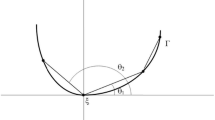Abstract
For many applications in the theory of flow through porous media, diffusion, convective transport, and electrical and heat conduction it is important to consider problems involving systems of blocks separated by boundaries (in particular, cracks or conductors), the transport process taking place both through the blocks themselves and along the separating boundaries. Such problems can conveniently be solved by the method of boundary integral equations [1–4]. The object of this study is to propose a form for these equations and methods of solving them specially designed to take into account the particularities of the problems in question. Firstly, the boundary integral equation is given in a form that contains only the net inflow (of fluid, heat or electricity) to a unit area of the boundary and not the individual inflows from each of the blocks separated from that boundary. This almost halves the number of unknowns subject to determination. Secondly, the principal aspects associated with the specifics of the flow along the boundaries and their intersections and discontinuities are discussed. Thirdly, a numerical experiment to realize the proposed form of the equations on a computer using algorithms with different structures leads to quite general conclusions which may be useful for further developing the method of boundary integral equations in relation to the class of applied problems considered.
Similar content being viewed by others
Literature cited
The Method of Boundary Integral Equations [Russian translation], Mir, Moscow (1978).
C. A. Brebbia and S. Walker, Boundary Element Techniques in Engineering, London (1980).
P. K. Banerjee and R. Butterfield, Boundary Element Methods in Engineering Science, London (1981).
A. M. Shapiro and J. Andersson, “Steady state fluid response in fractured rock: a boundary element solution for a coupled discrete fracture continuum model,” Water Resour. Res.,19, 959 (1983).
A. M. Lin'kov, “Plane problems of statistical loading of a piecewise-homogeneous linear-elastic medium,” Prikl. Mat. Mekh.,47, 644 (1983).
Author information
Authors and Affiliations
Additional information
Translated from Izvestiya Akademii Nauk SSSR, Mekhanika Zhidkosti i Gaza, No. 6, pp. 72–78, November–December, 1986.
The authors are grateful to their hydrogeologist colleagues at the All-Union Institute of Mining Geomechanics and Surveying (VNIMI) and the Leningrad Mining Institute for taking a stimulating interest in their work over a period of three years and for discussing its various applications.
Rights and permissions
About this article
Cite this article
Zubkov, V.V., Lin'kov, A.M. Boundary integral equations of fluid flow and electrical and heat conduction in a medium composed of blocks. Fluid Dyn 21, 905–911 (1986). https://doi.org/10.1007/BF02628026
Received:
Issue Date:
DOI: https://doi.org/10.1007/BF02628026



